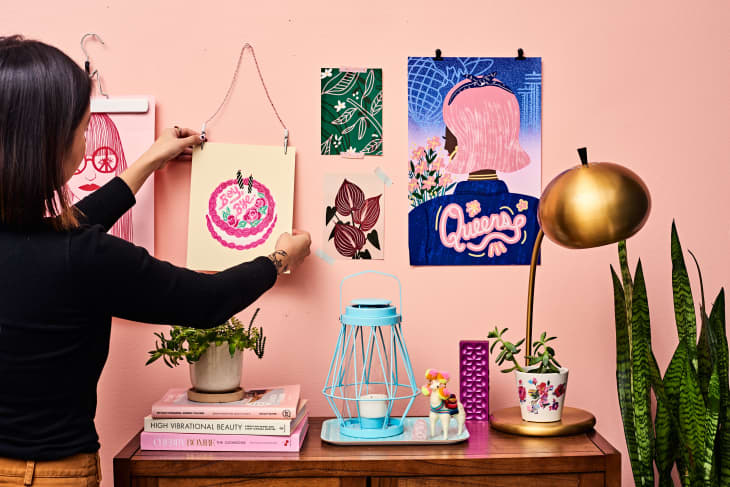6 Tips from Seasoned DIYers for Actually Finishing Your Home Projects This Year

There are the DIY projects that you can tackle in a weekend — and then there are those that require looking at the full year holistically and wondering how on earth you’re going to get it all done. If your 2022 goals involve one of those DIY remodeling projects and you’re feeling lost on where to start, look no further.
Three seasoned DIYers with everything from drywall to molding under their [tool] belts are sharing their top tips for planning, executing and finishing your DIY renovations by the time the clock strikes midnight on Dec. 31, 2022 (or, hopefully, long before).
Consider every task and its timeframe.
Content creator and DIYer Dominique Gebru has tackled everything from a bookworm’s dream wall to a modern take on arched drywall, and she offers straight-to-the-point advice for would-be DIYers. “Large-scale DIY projects are considered challenging for a reason,” she says. But Gebru has developed a system to help the process go smoothly.
“Start by writing down all of the discrete tasks that you think you’ll need to accomplish as part of the project,” Gebru recommends. “For example, I recently added drywall archways to our condo’s entryway. That included framing everything with two by fours, attaching the drywall, mudding the drywall, priming and painting. Not to mention this was my first time working with drywall, so add in many hours’ worth of YouTube videos.”
She then advises DIYers to take a look at their schedule — as in life, not DIY — and compare it with their proposed project time frame. Blocking out time specifically is key. “Write out exactly how many hours and at what time of day you plan to get those individual tasks done,” Gebru says. “I like to organize everything into a spreadsheet — it gave me a road map to look at while I was spiraling mid-drywall project.” And don’t forget to add in extra time, since DIY projects never go as quickly as planned.
Melissa Lee of East End Home agrees, noting that your available time should be a deciding factor in the projects you take on. “Budget time according to the scope of your project and remember that you’ll feel better accomplishing something smaller than feeling defeated when a project doesn’t get finished,” Lee says.
Create a vision board.
For Meghan Grant, the DIYer behind I’m Fixin’ To, this is a must. “I start every DIY with a vision board, even on the most basic project,” Grant says. She pulls inspiration for both ideas and specific products from Instagram and Pinterest and narrows her selections down to an actionable vision that is attainable within her budget and timeline. Sometimes that means creating a board for an entire room, but, currently, she’s working on a primary bedroom closet. That, too, got a vision board.
Be patient and gather everything you need.
With supply chains in their current state of flux, Gebru recommends waiting until you have everything you need in hand — the last thing you want to do is put a stop on work because you can’t get a critical piece of the DIY puzzle. “Yes, you might need to run out to the hardware store to pick up an item here and there,” Gebru says. “But that’s better than having to halt mid-project while you wait for a major component to come back in stock.”
Lee expands on the idea, advising DIYers to be patient and wait it out when items are out of stock or require a few months of additional saving. When it comes to saving up to get what you really want, instead of a cheaper substitution, Lee speaks from experience. “It’s worth the wait,” she says. “You’ll appreciate what you get and end up saving money in the long run.”
Don’t leave the completion date open-ended.
It can be tempting to jump in, but the experts would advise against starting until you have a beginning, middle, and end on the calendar. As Grant works through her closet overhaul, a project that disrupts the her daily routine, she says having an end date keeps her focused. “I find it helpful to have a projected “due date” for completion,” Grant says. “With a firm end date, I can plan and make a checklist to work through. While there will always be unexpected bumps, having a due date and an organized to-do list makes the project flow as smoothly as possible.”
Outsource when necessary.
Even on DIY projects, there’s no shame in bringing in the professionals if you need them. “Outsource parts of the project that are too complicated or time consuming,” Lee advises. In her case, she knew she could learn to lay tile — but with two kids and a full time job, it didn’t make sense. Looking back, she says, “It was worth spending some extra money to pay someone else to do it!” Consider the cost-benefit and don’t feel bad hiring a pro.
Remember, it’s a journey.
Everything will get done in time, including your DIYs. “In 2021 we tried to accomplish too much,” Lee says. “There were moments at the end of the year where I looked around and felt discouraged. But design is a journey and some journeys take more time than others! Embrace the process and enjoy the wins along the way.”
Take note of your small wins as you go to stay motivated and see your project through to the end. By December, you’ll have created something to be proud of — and will have more hands-on experience under your belt, too.